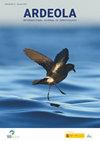Nest Features and Nesting Niche Segregation in Five Iberian Steppe Passerines
IF 1.2
4区 生物学
Q2 ORNITHOLOGY
引用次数: 2
Abstract
Summary. The co-occurrence of morphologically similar species may be enabled by differences in resource use that limit the effects of interspecific competition, allowing coexistence. This study aimed to evaluate differences in nest structure and to characterise nesting microhabitats to test for nesting niche segregation among sympatric steppe passerines. From 2016 to 2019, we monitored and characterised the nest structure and nesting habitat of 71 nests from five sympatric passerines in shrub steppes in Central Spain: the Eurasian Skylark Alauda arvensis, the Greater Short-toed Lark Calandrella brachydactyla, Dupont's Lark Chersophilus duponti, the Tawny Pipit Anthus campestris and the Western Black-eared Wheatear Oenanthe hispanica. Nest structure was characterised by eight morphometric variables, while principal component analyses (PCA), MANOVA and univariate ANOVA were performed to characterise and evaluate differences in nesting microhabitat between species in both horizontal and vertical dimensions. All species built their nests under short vegetation (< 20cm) and with a similar nest depth. However, there were significant differences among species for some of the considered variables. For example, the three monitored lark species built their nests in areas with lower plant cover compared to the two non-lark species. GLM on PCA axes showed that some species differed in some aspect of nesting niche. In general, the Eurasian Skylark built its nests in areas with higher grassland cover, while the Greater Short-toed Lark selected more open areas, with a higher bare ground cover. Dupont's Lark, the Tawny Pipit and the Western Black-eared Wheatear nested mainly in shrubby areas dominated by chamaephytes. Overall, our results suggest the existence of nesting microhabitat segregation, mainly of the Eurasian Skylark with the rest of the species, which may contribute to explaining the coexistence between species that could potentially compete for nesting sites. This work contributes to understanding how differences in species nest site preferences may facilitate coexistence between similar sympatric species.—Barrero, A., Cortés Caballero, B., Reverter, M., Gómez-Catasús, J., Bustillo-de la Rosa, D., Zurdo, J., Pérez-Granados, C. & Traba, J. (2023). Nest features and nesting niche segregation in five Iberian steppe passerines. Ardeola, 70: 201-224. Resumen. La coexistencia de especies morfológicamente similares puede estar motivada por diferencias en el uso de los recursos que limitan los efectos de la competencia interespecífica, permitiendo la coexistencia. Este estudio tiene como objetivo evaluar las diferencias en la estructura de los nidos y caracterizar los microhábitats de nidificación para probar la segregación del nicho de nidificación entre paseriformes esteparios simpátricos. Entre 2016 y 2019 se monitorizó y caracterizó la estructura del nido y el hábitat de nidificación de 71 nidos de cinco paseriformes simpátricos en estepas arbustivas del centro de España: alondra común Alauda arvensis, terrera común Calandrella brachydactyla, alondra ricotí Chersophilus duponti, bisbita campestre Anthus campestris y collalba rubia Oenanthe hispanica. La estructura de los nidos se caracterizó mediante ocho variables morfométricas mientras que se realizaron análisis de componentes principales (PCA), MANOVA y ANOVA univariante para caracterizar y evaluar las diferencias en el microhábitat de nidificación entre parejas de especies tanto a escala horizontal como vertical. Todas las especies construyeron sus nidos bajo vegetación corta (< 20 cm) y con una profundidad de nido similar; sin embargo, mostraron diferencias entre las especies para algunas de las variables consideradas. Por ejemplo, las tres especies de aláudido construyeron sus nidos en zonas con menor cobertura vegetal en comparación con las otras dos especies. Los GLM sobre los ejes del PCA mostraron que algunas de las especies diferían en algún aspecto del sitio de nidificación. En general, la alondra común construyó sus nidos en zonas con mayor cobertura de pastizales, mientras que la terrera común seleccionó zonas más abiertas, con mayor cobertura de suelo desnudo. La alondra ricotí, el bisbita campestre y la collalba rubia anidaron principalmente en zonas arbustivas dominadas por caméfitos. En general, nuestros resultados sugieren la existencia de una segregación del microhábitat de nidificación, principalmente de la alondra común con el resto de las especies, que puede contribuir a explicar la coexistencia entre especies que podrían competir por los lugares de nidificación. Este trabajo contribuye a comprender cómo las diferencias en las características del lugar de nidificación de las especies pueden facilitar la coexistencia entre especies simpátricas similares.—Barrero, A., Cortés Caballero, B., Reverter, M., Gómez-Catasús, J., Bustillo-de la Rosa, D., Zurdo, J., Pérez-Granados, C. y Traba, J. (2023). Características de los nidos y la segregación del nicho de nidificación en cinco paseriformes esteparios ibéricos. Ardeola, 70: 201-224.伊比利亚草原五种雀形目鸟类的巢特征和巢位分离
五种伊比利亚草原雀形目鸟类的巢型特征及筑巢生态位分离。他的父亲是一名律师,母亲是一名律师。
本文章由计算机程序翻译,如有差异,请以英文原文为准。
求助全文
约1分钟内获得全文
求助全文
来源期刊
CiteScore
2.30
自引率
6.20%
发文量
16
审稿时长
>12 weeks
期刊介绍:
Ardeola: International Journal of Ornithology is the scientific journal of SEO/BirdLife, the Spanish Ornithological Society. The journal had a regional focus when it was first published, in 1954. Since then, and particular during the past two decades, the journal has expanded its thematic and geographical scope. It is now a fully international forum for research on all aspects of ornithology. We thus welcome studies within the fields of basic biology, ecology, behaviour, conservation and biogeography, especially those arising from hypothesis-based research. Although we have a long publication history of Mediterranean and Neotropical studies, we accept papers on investigations worldwide.
Each volume of Ardeola has two parts, published annually in January and July. The main body of each issue comprises full-length original articles (Papersand Review articles) and shorter notes on methodology or stimulating findings (Short Communications). The publication language is English, with summaries, figure legends and table captions also in Spanish. Ardeolaalso publishes critical Book Reviewsand PhD-Dissertation Summaries; summarising ornithological theses defended in Spain. Finally there are two Spanish-language sections, Ornithological News; summarising significant recent observations of birds in Spain, and Observations of Rare Birds in Spain, the annual reports of the Spanish Rarities Committee.

 求助内容:
求助内容: 应助结果提醒方式:
应助结果提醒方式:


